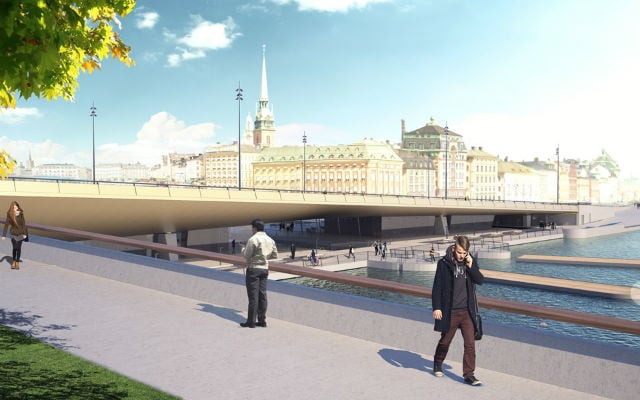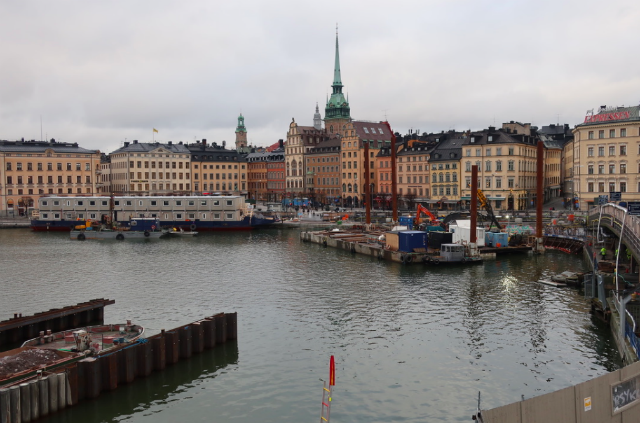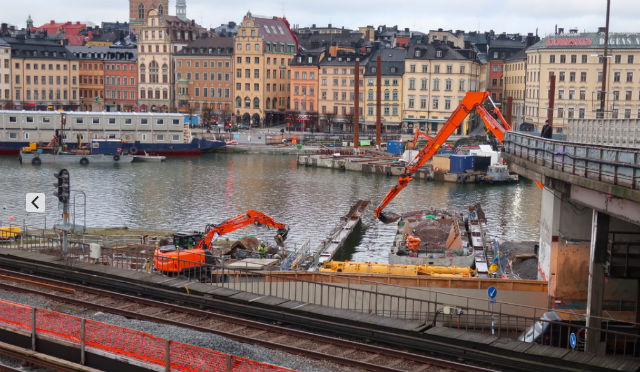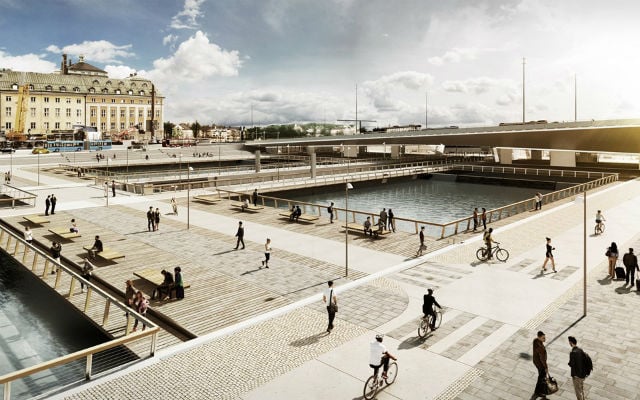The real reason for Stockholm’s massive Slussen redevelopment
Amid the ferocity of the protests to ‘Save old Slussen!’, the real -- and potentially devastating -- reason for the controversial redevelopment has effectively been drowned out.

If you’re visiting Stockholm in the near future and stroll from the cobbled streets of Old Town to the hip district of Södermalm, you’ll witness one of Scandinavia’s biggest building projects.
Giant crane vessels plunge steel pillars into the silt of the Baltic, bulldozers push truck-loads of 80-year-old rubble, exposed iron bars jut from half-demolished concrete structures. The entire area is an unignorable rumbling, clanging building site -- and will be for another seven years.
This is Slussen, the mouth of Lake Mälaren as it spills into the Baltic Sea and the crucial meeting point of rail, water, and road traffic coming into the city. It’s Sweden’s second-largest public transport hub after Stockholm Central Station, used by around 400,000 people each day.
And this figure is expected to rise by more than 25 percent to 505,000 by 2030, as the city’s swelling population leads to more pedestrians, cyclists, cars, and commuters.
What remains of the structure dates back to the mid-1930s when the cloverleaf interchange was built to remedy ‘Slussen Misery’, a continual traffic jam brought on by the arrival of the automobile. Thought to be the first of its kind in Europe, for over 80 years the interchange has been one of the country’s cardinal focal points.
And soon it will be entirely unrecognisable from the Slussen many Stockholmers have come to see as a symbol of their city.
A controversial project
It should come as no surprise that Slussen was beginning to show serious signs of wear and tear. Sections of the 83-year-old structure had sunk by up to 25 cm in places and were at risk of collapsing, posing a very real threat to public safety.
It’s one of the reasons behind the 12.1 billion kronor (€1.3 billion) project financed solely by the City of Stockholm to redevelop and retrofit the entire Slussen facility.
 The new main bridge. Illustration: ÅF Lighting
The new main bridge. Illustration: ÅF Lighting
The project, which began in 2016 and is scheduled to be completed by 2025, involves plans to build a safer and more effective juncture, along with developing the surrounding area into a vibrant new meeting place and centre for city life.
But protests to the redevelopment have been fierce.
Staunch opposition from citizens and celebrities was led by ABBA star Benny Andersson, who cried out to “Save old Slussen!”, arguing the plans were out of step with the local population’s wishes. Andersson even pledged to reunite his former group if the protests against the Slussen redevelopment proved successful.
But the effort failed to sway Stockholm’s city council, and shortly after, roadways were ripped away and cranes began sprouting up around the iconic interchange.
 Evidence of the construction project has been on display since work started in 2016.
Evidence of the construction project has been on display since work started in 2016.
Facilitating travel and protecting the hundreds of thousands of people that use Slussen each day is, of course, a pressing motive for the redevelopment. However, planners admit the project’s primary motivation was effectively drowned out by the fiery debate about urban design.
“Climate change is the main reason for the reconstruction, but people just don’t realise it,” says Eva Rosman, Communications Manager for the Slussen project.
Catastrophic consequences
It’s hard to escape the irony of a sustainability message failing to take centre stage and help galvanize consensus in a city that is otherwise eager to tout its climate-conscious credentials, and generally successful at bringing citizens onboard.
There wasn’t nearly as much fuss when it was announced one billion kronor (€102 million) would be invested to expand the city’s cycling infrastructure. Stockholmers even responded positively when a congestion charge was introduced in 2007 to reduce environmental issues resulting from vehicular traffic.
Yet when it comes to Slussen, the critical climate impetus, which if left unaddressed could have catastrophic consequences, seems to have been muffled by the din of the protests.
And while the heated public debate about Slussen’s new design may have prevented the public from realizing it was also an ambitious measure to protect the city against the effects of climate change, that doesn’t diminish the urgency of taking action, warns Richard J. T. Klein, Senior Research Fellow at Stockholm Environmental Institute.
“Climate change is happening and its effect on nature, people, and the economy will increase over time,” he explains.
Moreover, research conducted by the Swedish Meteorological and Hydrological Institute (SMHI) found that the original Slussen construction, which besides acting as a transport hub is first and foremost a navigation lock, was not built to withstand the projected sea level rise brought on by climate change.
 The Slussen project is necessary to protect the drinking water for everyone living in the Mälaren region.
The Slussen project is necessary to protect the drinking water for everyone living in the Mälaren region.
“Large-scale infrastructure projects like Slussen are designed to exist for many decades, so long-term changes in the water level of Mälaren and the Baltic Sea need to be taken into account,” says Klein
“It was a wise decision to integrate climate risk into the new design as the extra costs incurred are easily justified by the much higher potential of flood damages.”
And the clock is ticking.
From 2050 onwards rising sea levels will finally counteract Sweden’s ‘land uplift’, a geological process that has been taking place since the end of the Ice Age, causing the land to rise relative to the sea. This is expected to raise levels of the Baltic Sea outside Stockholm by around half a metre by 2100.
Floods and contaminated drinking water
In addition to rising sea levels, climate change is also expected to alter weather patterns over Sweden, resulting in more precipitation flowing into Lake Mälaren, a major national sea route that flows to the Baltic through the locks at Slussen.
“The effects of climate change will mean more rain in winter, so the lake will rise and pose a huge flooding risk to the whole area,” warns Rosman.
Stretching 120 km from east to west, Lake Mälaren touches several counties including Stockholm, Uppsala, Södermanland, Örebro, and Västmanland, and provides fresh drinking water to more than two million people.
If the Slussen locks aren’t able to drain properly, all of the towns surrounding the lake will be vulnerable to flooding that could damage critical infrastructure like electric utilities and, crucially, contaminate the drinking water for the entire region.
“It’s not just Slussen and Gamla Stan, or even the shoreline of Stockholm that makes this project crucial,” says Linda Holmström, Policy Advisor for Stockholm’s Climate Unit.
“It will affect all the municipalities on Lake Mälaren, all the way up to Västerås and Eskilstuna. This is a measure Stockholm is taking to save drinking water for the whole region.”
Building resilience
It’s not the first time in recent years that Lake Mälaren has risked contamination from the Baltic.
“In 2000, there was a flood and the metro station at Gamla Stan was about 10 cm away from being flooded,” remembers Rosman. “So we opened all the locks in Stockholm and Södertälje to avoid the incident. It took two to three years before the water returned to its normal quality.”
Under current conditions, SMHI estimates there is a 10 percent chance of an even worse flood occurring in the next decade.
To counter this risk, protecting the lake’s surrounding infrastructure and safeguarding the provision of clean drinking water, the New Slussen project will redesign and retrofit the existing structure, incorporating elements of climate resilience. The new facility is intended to last for the next hundred years.
 New Slussen will release five times more water than the old structure. Illustration: White Arkitekter.
New Slussen will release five times more water than the old structure. Illustration: White Arkitekter.
The foundations of the new Slussen will be built to easily withstand current conditions and handle heavier loads from rising sea levels along with accommodating higher floodgates.
“The main thing we have to do is increase capacity,” says Rosman, explaining that the output for the new lock will be five times as much as it was previously.
This will be achieved by building two larger channels beside the lock, one 33 metres wide and the other 35 metres wide. Together they will be able to release up to 1,400 m3/s of water.
Combined with a new water regulation plan which involves letting Mälaren behave more like a natural lake, allowing for more water in springtime and less in the summertime, the present vulnerabilities will be countered and controlled.
A global trend
Stockholm isn’t alone in taking these precautions.
Cities around the world are preparing for the effects of climate change, which besides rising sea levels, is also expected to involve include subsidence and an increase in the intensity of coastal storms and hurricanes.
New York will become the first major city to be remapped in response to the potential future effects of global climate change, while Boston is strategising to protect the 30 percent of its land that could be swallowed by rising sea levels by the end of the 21st century.
In Europe, cities like Hamburg, Rotterdam, and London have invested large amounts into coastal flood preparedness.
“As sea level rise accelerates, more cities will have to follow their lead,” says Klein.
He adds that three of the five biggest risks highlighted in the World Economic Forum’s Global Risk Report are climate change related. However, he remains hopeful that more cities will follow in the steps of the Slussen project, reducing the risk of weather and climatic hazards.
“The severity of the climate challenge is huge, but so is human ingenuity and creativity. Because we’ve waited so long, we need to invest in measures to address the impacts of climate change, which are now unavoidable.”
This article was produced independently with support from the City of Stockholm.
Click here to learn more about different types of sponsored content on The Local.
This content was paid for by an advertiser and produced by The Local's Creative Studio.

Join the conversation in our comments section below. Share your own views and experience and if you have a question or suggestion for our journalists then email us at [email protected].
Please keep comments civil, constructive and on topic – and make sure to read our terms of use before getting involved.
Please log in here to leave a comment.